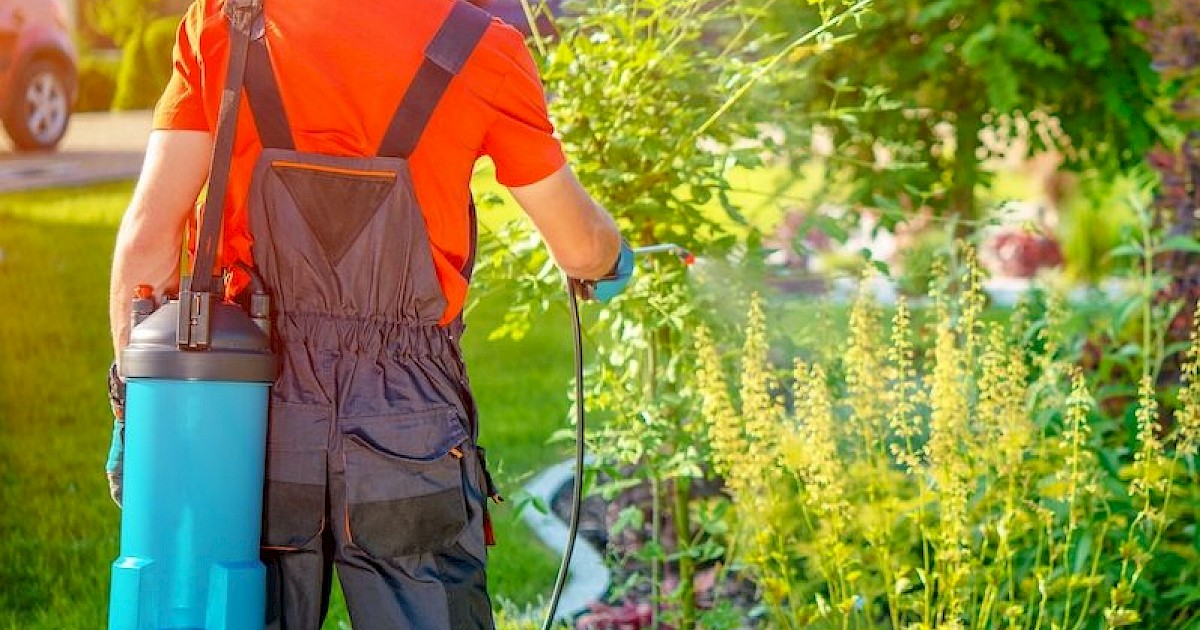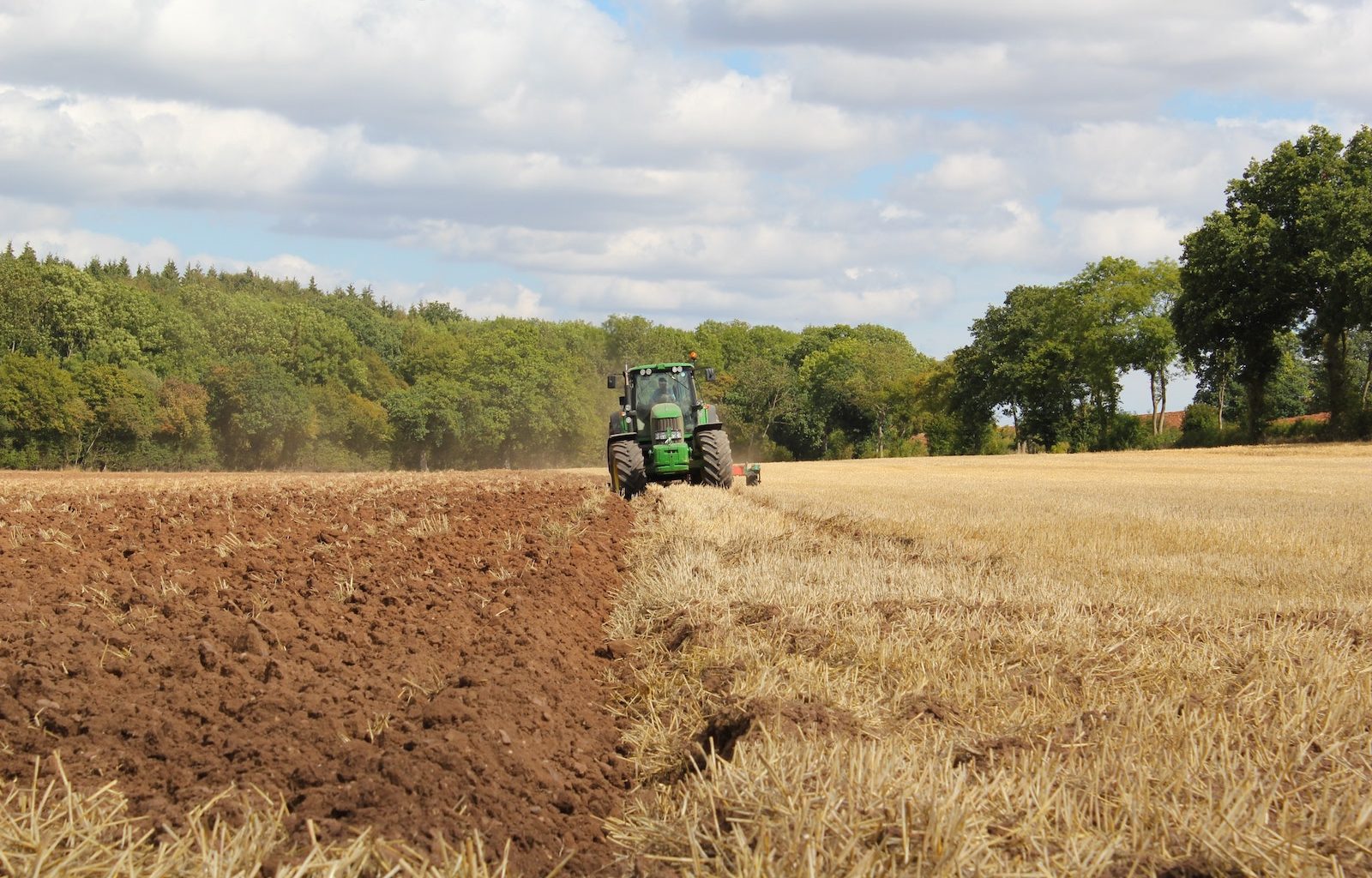Home>Gardening News and Trends>Latest News>What Is The Difference Between Pesticides And Herbicides


Latest News
What Is The Difference Between Pesticides And Herbicides
Modified: January 22, 2024
Stay updated with the Latest News on the Difference Between Pesticides and Herbicides. Understand the distinctions and make informed choices for your agricultural needs.
(Many of the links in this article redirect to a specific reviewed product. Your purchase of these products through affiliate links helps to generate commission for Chicagolandgardening.com, at no extra cost. Learn more)
Table of Contents
- Introduction
- Definition of Pesticides
- Definition of Herbicides
- Comparison of Pesticides and Herbicides
- Types of Pesticides
- Types of Herbicides
- Use of Pesticides
- Use of Herbicides
- Environmental Impact of Pesticides
- Environmental Impact of Herbicides
- Safety Considerations for Pesticides
- Safety Considerations for Herbicides
- Conclusion
Introduction
When it comes to protecting crops and managing unwanted vegetation, the use of pesticides and herbicides has become prevalent in the agricultural industry. These substances play a crucial role in ensuring optimal yields and controlling pests or weeds that can jeopardize crop health and productivity. However, despite their similar purpose, pesticides and herbicides differ in terms of their application and target organisms.
Pesticides, as the name suggests, are chemical or biological agents specifically designed to combat pests that pose a threat to crops. These pests can include insects, mites, fungi, bacteria, and viruses. On the other hand, herbicides are substances used to manage and eradicate unwanted vegetation, primarily weeds. While both pesticides and herbicides aim to protect crops, they have distinct properties and modes of action.
Understanding the differences between pesticides and herbicides is essential for farmers, gardeners, and consumers. In this article, we will explore the characteristics, types, and uses of pesticides and herbicides. We will also delve into the environmental impacts and safety considerations associated with their usage. By gaining this knowledge, individuals can make informed decisions about agricultural practices and ensure the responsible use of these substances.
Definition of Pesticides
Pesticides are chemical or biological substances that are used to control and eliminate pests that can damage crops, transmit diseases, or pose a threat to public health. These pests can include insects, mites, fungi, bacteria, and viruses. Pesticides work by interfering with the pest’s physiological processes, inhibiting their growth, reproduction, or causing direct mortality.
There are different types of pesticides available, each designed to target specific pests or groups of pests. Insecticides, for example, are pesticides specifically formulated to control and eradicate insect populations. They may act by disrupting the insect’s nervous system, inhibiting their development, or interfering with their feeding and reproduction. Fungicides, on the other hand, are used to combat fungal infections that can lead to diseases in plants or crops.
Pesticides can be classified into two main categories: synthetic pesticides and natural or biological pesticides. Synthetic pesticides are chemically synthesized compounds that are created in laboratories. They are often highly effective in controlling pests but may have unintended consequences on the environment and non-target organisms if not used properly. Natural or biological pesticides, on the other hand, are derived from naturally occurring substances such as plants, bacteria, or minerals. These pesticides are often considered more environmentally friendly, but their efficacy may vary depending on the target pests and the specific formulation.
The use of pesticides has revolutionized agriculture by reducing crop losses caused by pests, increasing yields, and ensuring food security. However, the widespread use of pesticides has raised concerns about their potential negative impacts on human health and the environment. It is crucial to use pesticides responsibly, following recommended guidelines and regulations, to minimize any adverse effects.
Definition of Herbicides
Herbicides are chemical substances used to manage and control unwanted vegetation, primarily weeds. Weeds compete with crops for sunlight, water, and nutrients, reducing crop yields and hindering agricultural productivity. Herbicides are specifically designed to target and eradicate these unwanted plants, allowing crops to thrive.
Just like pesticides, herbicides come in various formulations and types, each effective against specific weed species or groups. Selective herbicides target specific types of weeds while leaving the desired crops unharmed. Non-selective herbicides, on the other hand, are designed to kill any vegetation they come into contact with. They are often used in non-cropland areas, such as industrial sites or along roadways, to completely clear unwanted vegetation.
Herbicides work by interfering with the growth and development of plants. They can inhibit enzymes necessary for photosynthesis, disrupt the plant’s hormonal balance, or block essential metabolic pathways. Some herbicides are formulated to be absorbed by the foliage, while others are applied to the soil, preventing weed germination or growth.
Similar to pesticides, herbicides can be synthetic or natural. Synthetic herbicides are chemically synthesized compounds created to specifically target weeds. They often provide efficient weed control but should be used carefully to avoid harming desired crops or causing environmental contamination. Natural or organic herbicides, derived from plant extracts or other natural substances, offer an alternative for those seeking more environmentally friendly weed control methods. These herbicides may have a lower impact on non-target organisms and ecosystems.
Herbicides play a crucial role in maintaining the productivity and health of agricultural lands. By minimizing weed competition, they allow crops to access essential resources and thrive. Proper application and responsible use of herbicides are essential to prevent unintended damage to desired plants and to ensure the minimal impact on ecosystems and water quality.
Comparison of Pesticides and Herbicides
Pesticides and herbicides share a common purpose of protecting crops and managing agricultural pests, but they differ in terms of their target organisms and modes of action.
One of the key differences between pesticides and herbicides is their target organisms. Pesticides are used to control a wide range of pests, including insects, mites, fungi, bacteria, and viruses. Their aim is to protect crops from damage and disease caused by these organisms. Herbicides, on the other hand, specifically target unwanted plants, primarily weeds, which compete with crops for essential resources. By effectively controlling weeds, herbicides help optimize crop growth and maximize yields.
In terms of their modes of action, pesticides and herbicides also differ. Pesticides often work by targeting specific physiological processes of pests, such as their nervous system or reproductive capabilities. They may disrupt the communication between insects, hinder their feeding or movement, or cause direct mortality. Herbicides, on the other hand, typically interfere with the growth and development of plants. They can inhibit essential enzymes for photosynthesis, disrupt hormonal balance, or prevent cell division, ultimately leading to the death of unwanted vegetation.
Another significant distinction between pesticides and herbicides is their selectivity. Pesticides can be broad-spectrum, meaning they are effective against a wide range of pests, or they can be more specific, targeting a particular group of insects or diseases. Herbicides can also be selective or non-selective. Selective herbicides are designed to target specific weed species while leaving desired crops unharmed. Non-selective herbicides, on the other hand, kill any vegetation they come into contact with, which makes them suitable for clearing non-cropland areas or controlling broad-spectrum weed infestations.
When it comes to their environmental impact, both pesticides and herbicides have raised concerns about potential harm to non-target organisms, water sources, and ecosystems if used improperly. Therefore, responsible application and adherence to safety guidelines are crucial for minimizing any adverse effects that these substances may have.
Understanding the differences between pesticides and herbicides is essential for farmers, gardeners, and consumers. It allows for informed decision-making when it comes to choosing and using these substances, considering their specific needs and environmental implications.
Types of Pesticides
Pesticides can be classified into several different types, each designed to target specific pests or groups of pests. These types of pesticides include insecticides, fungicides, herbicides, rodenticides, and bactericides.
Insecticides: Insecticides are pesticides specifically formulated to control and eradicate insect populations. They act by disrupting the nervous system of insects, inhibiting their growth and development, or interfering with their feeding and reproduction. Insecticides can be further categorized based on their mode of action, such as contact insecticides that kill insects upon direct contact, systemic insecticides that are absorbed by plants and ingested by insects, or stomach poisons that are ingested by insects and kill them when they feed.
Fungicides: Fungicides are used to combat fungal infections in plants and crops. Fungi can cause devastating diseases that affect plant health and reduce productivity. Fungicides work by preventing fungal spore germination, inhibiting fungal growth and reproduction, or disrupting fungal cell membranes. They are especially important in agricultural settings where crop diseases caused by fungi can result in significant economic losses.
Herbicides: Herbicides are the pesticides specifically designed to manage and control unwanted vegetation, primarily weeds. There are different types of herbicides available, including selective herbicides that target specific weed species while leaving desired crops unharmed and non-selective herbicides that kill any vegetation they come into contact with. Herbicides can be applied to foliage or soil, preventing weed germination or growth and allowing crops to access essential resources.
Rodenticides: Rodenticides are pesticides formulated to control rodent populations. They are commonly used in agricultural and urban settings to manage mice, rats, and other small mammal pests. Rodenticides work by disrupting the rodent’s nervous system, causing internal bleeding, or interfering with their ability to digest food.
Bactericides: Bactericides are pesticides that specifically target and control bacterial infections in plants. They can be used to prevent or manage diseases caused by bacterial pathogens. Bactericides may work by inhibiting bacterial growth or disrupting essential cellular processes in bacteria.
It is important to note that some pesticides may fall into multiple categories, as they can have a broad spectrum of action against different pests. Additionally, advancements in pesticide technology continue to drive the development of new formulations and types that are more effective, safer, and environmentally friendly.
Types of Herbicides
Herbicides are categorized into various types, each designed to target and manage unwanted vegetation, primarily weeds. These types of herbicides include selective herbicides, non-selective herbicides, pre-emergent herbicides, and post-emergent herbicides.
Selective Herbicides: Selective herbicides are designed to control specific types of weeds while leaving desired crops or plants unharmed. These herbicides work by targeting certain biochemical pathways or enzymes that are specific to the weed species. They are commonly used in agricultural settings where weed competition can reduce crop yields. Selective herbicides allow farmers to effectively manage weeds without causing significant damage to their cultivated crops.
Non-Selective Herbicides: Non-selective herbicides are formulated to kill or control any vegetation they come into contact with. These herbicides are used in areas where complete vegetation control is desired, such as non-cropland areas or during site preparation for new plantings. Non-selective herbicides are effective against a wide range of weed species, including grasses, broadleaf weeds, and woody plants.
Pre-emergent Herbicides: Pre-emergent herbicides are applied to the soil before weed seeds begin to germinate. They form a barrier or inhibit the growth of weed seedlings, preventing them from emerging and establishing in the first place. Pre-emergent herbicides are particularly effective in preventing annual weeds and can provide long-lasting control during the growing season. These herbicides are commonly used in agricultural fields, gardens, and landscapes to minimize weed growth.
Post-emergent Herbicides: Post-emergent herbicides are applied to actively growing weeds. They work by either being absorbed through the foliage and translocated to the rest of the plant or by inhibiting specific metabolic pathways in the weed. Post-emergent herbicides are useful for targeting existing weed populations during the growing season. They can be selective, targeting specific types of weeds while leaving desired plants unharmed, or non-selective, killing any vegetation they come into contact with.
It is important to note that different herbicides may have different modes of action and target different types of weeds. Some herbicides may be effective against broadleaf weeds, while others are more suited for grassy weeds. Additionally, herbicide formulations may be available in various forms, including liquid concentrates, granules, or ready-to-use sprays, to accommodate different application methods and target areas.
Choosing the appropriate type of herbicide depends on the specific weed problem, the desired level of vegetation control, and the type of plants or crops being grown. It is essential to carefully read and follow the label instructions, considering factors such as timing, rates, and safety precautions, to ensure effective and responsible use of herbicides.
Use of Pesticides
Pesticides play a crucial role in modern agriculture by protecting crops from pests and diseases, ensuring optimal yields, and safeguarding food security. The use of pesticides helps farmers mitigate crop losses and increase productivity. However, it is important to use pesticides responsibly and follow recommended guidelines to minimize potential risks to human health and the environment.
One of the primary uses of pesticides is pest management. Farmers apply pesticides to control insect pests, mites, fungi, bacteria, and viruses that can damage crops and reduce yields. By targeting specific pests, pesticides help farmers maintain crop health and protect their investment. Pesticides also play a significant role in agricultural practices such as integrated pest management (IPM), where the use of pesticides is combined with other strategies to reduce pest populations and minimize environmental impact.
Pesticides are used throughout the crop production process. Before planting, soil fumigants or pre-plant insecticides may be applied to control soil-dwelling pests and diseases. During the growing season, pesticides are applied to protect crops from damage caused by insects, diseases, or weeds. These can include foliar sprays, granular formulations, or seed treatments that provide targeted protection against specific pests.
In addition to agricultural applications, pesticides are also used in non-agricultural settings, such as public health. Insecticides, for example, are employed to control disease-carrying pests like mosquitoes and ticks, helping to prevent the spread of vector-borne diseases. Pesticides are used in residential areas to control pests like ants, cockroaches, and termites, improving living conditions and reducing health risks associated with pest infestations.
However, it is important to recognize that the use of pesticides carries potential risks and should be conducted responsibly. Over-reliance on pesticides can lead to the development of resistance in pests, requiring greater amounts or different formulations to achieve effective control. Pesticides can also have unintended consequences on non-target organisms, beneficial insects, wildlife, water sources, and ecosystems. Therefore, it is crucial to follow label instructions, apply pesticides at the recommended rates and timings, and adopt integrated pest management techniques to minimize the impact on the environment.
Regular monitoring, proper storage, and disposal of pesticide containers, and adherence to safety precautions are essential for the responsible use of pesticides. Additionally, ongoing research and development aim to improve the efficacy and safety of pesticides, as well as to explore alternative pest management strategies that reduce reliance on chemical control.
Overall, the use of pesticides is an essential tool for farmers, gardeners, and public health professionals in managing pests and protecting crops and human health. By following best practices and considering environmental and safety factors, the benefits of pesticide use can be maximized while minimizing potential risks.
Use of Herbicides
Herbicides are vital tools in weed management, allowing farmers, gardeners, and land managers to control and eliminate unwanted vegetation. The use of herbicides helps to improve crop yields, enhance aesthetics, and maintain the overall health and productivity of landscapes. However, responsible and judicious use of herbicides is essential to minimize potential risks and promote sustainable land management practices.
One of the primary uses of herbicides is in agriculture. Farmers apply herbicides to control weeds that compete with crops for vital resources such as sunlight, water, and nutrients. By effectively managing weeds, herbicides help to optimize crop growth and maximize yields. Selective herbicides are often used to target specific weed species while preserving the desired crop plant, allowing farmers to maintain weed-free fields and improve overall farm efficiency.
Herbicides are also utilized in non-agricultural settings. In landscaping and gardening, herbicides are employed to control weeds that can detract from the visual appeal and health of plants. By targeting unwanted vegetation, herbicides help to maintain a clean and well-maintained appearance in lawns, gardens, and ornamental landscapes. Additionally, herbicides are used in industrial areas, roadsides, and utility sites to manage weeds and ensure safe and efficient operation.
Herbicides can be applied at different stages of weed growth, allowing for targeted control strategies. Pre-emergent herbicides are applied before weeds germinate, forming a barrier in the soil to prevent their emergence. This approach is particularly effective in preventing annual weed infestations. Post-emergent herbicides are applied to actively growing weeds, either by direct contact or through foliar absorption. They work by interrupting important physiological processes in the weed, ultimately leading to its death.
While herbicides offer many benefits, it is crucial to use them responsibly to minimize potential risks. Over-reliance on herbicides can lead to the development of herbicide-resistant weeds, which can limit the effectiveness of control methods. Therefore, integrating different weed management strategies, such as crop rotation, mulching, and manual weed removal, is important to reduce reliance on herbicides and maintain long-term weed control.
Adhering to label instructions, following recommended rates, application timings, and safety precautions is essential when using herbicides. Applicators should consider environmental factors, including wind speed, temperature, and proximity to water sources, to minimize the potential for off-target drift and environmental contamination. Proper storage and disposal of herbicide containers are also crucial to prevent accidental spills and contamination.
Continued research and development in herbicide technology aim to improve effectiveness, reduce potential environmental impacts, and explore alternative weed management strategies. By staying informed and applying best practices, the use of herbicides can support sustainable weed control, maintain healthy vegetation, and improve the overall management of various landscapes and agricultural systems.
Environmental Impact of Pesticides
The use of pesticides in agriculture and other industries can have significant environmental impacts if not managed carefully. While pesticides play a crucial role in pest control and crop protection, their use can result in unintended consequences that affect ecosystems, non-target organisms, and water sources.
One of the primary concerns regarding pesticides is their potential harm to non-target organisms. Pesticides designed to target specific pests can sometimes affect other organisms that are beneficial to ecosystems. For example, insecticides used to control pests can also harm pollinators such as bees and butterflies, which play a vital role in plant reproduction and biodiversity. Additionally, herbicides, when used improperly, can impact beneficial plants and disrupt natural habitats for wildlife.
Pesticides can also have impacts on water quality and aquatic ecosystems. Runoff from fields and improper application can lead to water contamination, as pesticides may find their way into rivers, lakes, and groundwater. This can have detrimental effects on aquatic organisms, including fish, amphibians, and aquatic plants, disrupting the balance of these ecosystems. Some pesticides, especially those with persistent properties, can stay in the environment for extended periods, leading to long-term impacts.
Another concern is the potential for pesticide-resistant pests and weeds to develop. Over time, pests and weeds can build resistance to certain pesticide formulations, rendering them less effective. This can lead to a cycle of increased pesticide use and the development of further resistance, as stronger and more concentrated pesticides may be required to control resistant pests.
It is crucial to employ Integrated Pest Management (IPM) practices to mitigate the adverse environmental impacts of pesticides. IPM involves a combination of techniques, such as crop rotation, biological control, habitat manipulation, and proper pesticide use, to minimize the reliance on pesticides and promote sustainable pest management.
Efforts are underway to address the environmental impact of pesticides. Regulatory agencies rigorously evaluate and assess the safety and efficacy of various pesticides before granting approval for their use. Additionally, advancements in pesticide formulations and application techniques, such as precision agriculture and targeted spraying, aim to minimize off-target effects and reduce the overall environmental footprint of pesticide use.
Education, training, and awareness programs are crucial in promoting responsible pesticide use. Farmers, applicators, and consumers need to be knowledgeable about proper pesticide handling, application techniques, and safety precautions. Following label instructions, using appropriate protective equipment, and adhering to recommended dosage rates are essential practices for minimizing environmental impacts.
Continued research and innovation in pesticide development are focused on improving the selectivity and efficacy of pesticides while reducing their environmental impact. This includes the development of biopesticides, which are derived from natural sources and have a lower potential for environmental harm.
Overall, the environmental impact of pesticides can be effectively reduced through responsible use, integrated pest management strategies, and ongoing research and development efforts. Striking a balance between effective pest control and environmental stewardship is crucial for preserving ecosystems, protecting non-target organisms, and ensuring sustainable agricultural practices.
Environmental Impact of Herbicides
Herbicides, like any type of pesticides, can have significant environmental impacts if not used responsibly and in accordance with recommended guidelines. While herbicides are valuable tools in weed management, their use can result in unintended consequences that affect ecosystems, non-target plants, and water sources.
One of the primary environmental concerns associated with herbicides is their potential impact on non-target plants. Herbicides are designed to kill or control weeds, but they can also affect desirable plant species in close proximity. Overspray or drift from herbicide application can harm surrounding vegetation, including ornamental plants, crops, and native flora. This can disrupt ecosystem balance, decrease biodiversity, and have cascading effects on the food web and habitat availability for wildlife.
The use of herbicides can also affect water quality and aquatic ecosystems. Runoff from treated areas can carry herbicides into nearby water bodies, potentially contaminating rivers, lakes, and groundwater. The presence of herbicides in water sources can harm aquatic plants, algae, and organisms, disrupting ecosystem functioning and impairing water quality. Additionally, some herbicides have the potential to persist in the environment and bioaccumulate in organisms, leading to long-term effects on the food chain.
Herbicides can also contribute to the development of herbicide-resistant weeds. Over time, weeds can evolve and develop resistance to certain herbicides, requiring more intensive and diverse weed management strategies. The emergence of herbicide-resistant weeds necessitates the use of alternative herbicides or the adoption of non-chemical methods, which can increase the complexity and cost of weed control.
Responsible herbicide use is crucial to minimize environmental impact. Integrated Weed Management (IWM) approaches that combine various techniques such as crop rotation, mechanical cultivation, mulching, and biological control methods can help reduce reliance on herbicides and promote sustainable weed management practices.
Efforts are underway to develop and promote herbicides with improved environmental profiles. Research and innovation in herbicide formulation and application technology aim to enhance herbicide selectivity, reduce off-target effects, and increase efficacy at lower application rates. This includes the development of more targeted and site-specific application methods, reducing herbicide drift, and increasing the biodegradability of herbicide formulations.
Labels and guidelines provided by regulatory agencies, herbicide manufacturers, and industry organizations offer important information on proper herbicide use, application rates, timing, and safety precautions. Adhering to these recommendations, practicing proper herbicide storage and disposal techniques, and employing appropriate protective measures during application are essential for minimizing environmental impacts.
Education and training programs for farmers, applicators, and homeowners are crucial to promote responsible herbicide use. These initiatives can raise awareness about the potential risks associated with improper herbicide use and encourage the adoption of integrated approaches that combine various weed management strategies.
Through responsible use, ongoing research, and technological advancements, the environmental impact of herbicides can be effectively reduced. Balancing effective weed control with environmental stewardship is essential to minimize unintended consequences and ensure sustainable land management practices.
Safety Considerations for Pesticides
When it comes to using pesticides, ensuring safety is of utmost importance. Pesticides contain active ingredients that can be potentially harmful to humans, animals, and the environment if mishandled or used improperly. Understanding and following safety guidelines and precautions is crucial to minimize risks and protect both applicators and the surrounding environment.
One of the key safety considerations is personal protective equipment (PPE). Applicators should wear appropriate PPE, including gloves, long-sleeved clothing, goggles or face shields, and respiratory protection, as specified on the pesticide label. PPE provides a physical barrier between the pesticide and the skin, eyes, and respiratory system, reducing the risk of exposure and absorption.
Proper pesticide storage and disposal are also essential for safety. Pesticide containers should be stored in a secure and designated area, away from children, pets, food, and water sources. They should be kept in their original containers with the label intact to ensure accurate identification and instructions. Unused or expired pesticides should be disposed of according to local regulations and guidelines to prevent environmental contamination.
Applicators should carefully read and follow the pesticide label instructions. The label provides crucial information such as proper mixing, dilution rates, application techniques, re-entry intervals, and safety precautions. Adhering to the label instructions ensures effective and safe use of the pesticide while minimizing potential risks.
It is important to consider the environmental conditions before pesticide application. Factors such as wind speed and direction, temperature, and proximity to water sources should be taken into account to minimize the potential for pesticide drift or runoff. Applicators should avoid spraying during windy conditions and ensure that there is a buffer zone between the spraying area and sensitive habitats or water bodies.
Training and education on pesticide use and safety are essential for applicators and handlers. Applicators should receive proper training on pesticide handling, application techniques, and safety procedures. They should stay updated on new regulations, safety guidelines, and best practices to minimize risks and ensure responsible pesticide use.
Additionally, communication is important to protect bystanders and individuals in the vicinity of treated areas. Signs should be posted to notify people of pesticide application and establish restricted entry times or areas. Clear communication with neighbors, communities, and workers can help prevent unintended exposure or accidents.
In case of accidental pesticide exposure, prompt action should be taken. Applicators should be aware of the appropriate first aid measures outlined on the pesticide label and seek medical assistance if needed. It is important to document and report any incidents to relevant authorities for proper investigation and follow-up.
Regular monitoring and safety audits of pesticide use and storage areas can help to identify potential risks and ensure that safety protocols are being followed. Ongoing evaluation and adjustments to practices and equipment can contribute to maintaining a safe working environment.
By adhering to safety guidelines and implementing best practices, potential risks associated with pesticide use can be minimized. Prioritizing safety not only protects applicators and the environment but also ensures responsible and sustainable pesticide use.
Safety Considerations for Herbicides
When using herbicides, it is crucial to prioritize safety to minimize potential risks to humans, animals, and the environment. Herbicides contain active ingredients that can be harmful if mishandled or used improperly. By following safety considerations and guidelines, applicators can protect themselves and ensure responsible herbicide use.
Personal protective equipment (PPE) is essential when handling and applying herbicides. Applicators should wear appropriate PPE, including gloves, long-sleeved shirts, long pants, goggles or face shields, and respiratory protection, as recommended on the herbicide label. PPE acts as a barrier, reducing the risk of skin contact, inhalation, or eye exposure to the herbicide.
Proper storage and disposal of herbicides are critical for safety. Herbicide containers should be stored securely in a designated area, out of the reach of children, pets, and wildlife. It is important to store herbicides in their original containers with the label intact for accurate identification and instructions. Unused or expired herbicides should be disposed of according to local regulations to prevent environmental contamination.
Reading and understanding the herbicide label instructions is crucial for safe herbicide use. The label provides important information on proper mixing ratios, application rates, target weeds, precautions, and safety guidelines. Following the label instructions ensures effective herbicide application and minimizes the risk of unintended harm to non-target plants or areas.
Considering weather conditions and environmental factors is necessary before herbicide application. Wind speed and direction, temperature, humidity, and proximity to sensitive areas such as water bodies should be taken into account. Applicators should avoid spraying herbicides during windy conditions to prevent drift onto non-target areas and reduce the risk of contamination.
Training and education on herbicide use and safety are essential for applicators. Proper training ensures that applicators understand herbicide handling, mixing, application techniques, and safety precautions. Staying updated on new regulations, safety guidelines, and best practices helps applicators minimize risks and make informed decisions during herbicide application.
Effective communication is key to protect bystanders and individuals near treated areas. Signage should be posted to notify people of herbicide application and establish restricted entry times or areas. Proper communication with neighbors, communities, and workers helps prevent unintended exposure or accidents.
In the event of accidental herbicide exposure, immediate action should be taken. Applicators should follow the first aid measures outlined on the herbicide label and seek medical assistance if necessary. Documenting and reporting incidents to appropriate authorities is important for proper investigation and follow-up.
Regular monitoring and audits of herbicide use and storage areas help identify potential risks and ensure adherence to safety protocols. Evaluating and adjusting practices and equipment as needed contribute to maintaining a safe working environment.
By prioritizing safety considerations and following best practices, applicators can minimize risks and ensure responsible herbicide use. Prioritizing safety not only protects applicators but also helps preserve the environment and promote sustainable land management practices.
Conclusion
Pesticides and herbicides play critical roles in modern agriculture and weed management, helping to protect crops and ensure optimal yields. However, it is essential to use these substances responsibly and adhere to safety guidelines to minimize potential risks to human health, non-target organisms, and the environment.
Understanding the differences between pesticides and herbicides is essential for effective and appropriate use. Pesticides are designed to control various pests, such as insects, mites, fungi, bacteria, and viruses, while herbicides specifically target and manage unwanted vegetation, primarily weeds.
Various types of pesticides and herbicides are available, each designed to target specific pests or groups of pests. Insecticides, fungicides, herbicides, rodenticides, and bactericides provide options for different pest management needs. Selective and non-selective herbicides allow for targeted or broad-spectrum control of weeds.
The environmental impact of pesticides and herbicides is a significant concern. Both can have unintended effects on non-target organisms, water sources, and ecosystems if not used responsibly. Implementation of Integrated Pest Management (IPM) and Integrated Weed Management (IWM) approaches, along with ongoing research and innovation, can help mitigate these impacts and promote sustainable practices.
Safety considerations are paramount when working with pesticides and herbicides. Proper PPE, storage, and disposal are crucial for protecting applicators and minimizing environmental contamination. Adhering to label instructions, considering environmental conditions, and maintaining effective communication also play vital roles in ensuring safe use.
Continued education, training, and awareness programs are essential for promoting responsible and informed pesticide and herbicide use. Additionally, advancements in pesticide and herbicide formulations, application techniques, and alternative pest and weed management strategies contribute to minimizing environmental impacts.
By prioritizing safety, understanding the environmental implications, and adopting responsible practices, the benefits of pesticide and herbicide use can be maximized while minimizing potential risks. Striking a balance between effective pest and weed control and environmental protection is crucial for sustainable agricultural practices and land management.








